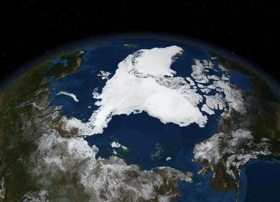by Simone Greene
(Washington)

The Arctic is Melting!
The arctic ice is getting thinner and melting as the average temperatures in the Arctic region are rising twice as fast as anywhere else in the world. Most scientists’ view what’s happening now in the Arctic as an indication of things to come; “a canary in the coal mine”.
For instance, the “Ward Hunt Ice Shelf” had been around for 3,000 years before it started cracking in 2000. Two years later it had split down the middle and now it continues to break into pieces. This “Ice Shelf” that was once solid and permanent enclosed a rare freshwater lake, supporting an exceptional ecosystem. However now that it has splintered away and the lake has disappeared into the ocean, polar bears, whales, walrus and seals are having to change their feeding and migration patterns making it harder for the native people to hunt. Along Arctic coastlines, entire villages are starting to be uprooted because they’re in danger of being swamped.
The melting ice sheets in Greenland and Antarctica are a fairly recent development that has taken scientists by surprise. They don’t know how to predict its effects just yet. But many fear it will mean the world’s coastlines are swamped much earlier than first thought.
In the past, the IPCC (International Panel of Climate Change) didn’t figure there would be large melt of ice in west Antarctica and Greenland this century and didn’t factor it into the predictions. Their forecasts were based only on the sea level rise from melting glaciers (which are different from ice sheets) and the physical expansion of water as it warms. But in 2002, Antarctica’s 3,250-square-kilometer Larsen B Ice Shelf broke off and disappeared in just 35 days. Recent NASA data shows that Greenland is losing 221 cubic kilometres of ice each year; twice the rate it was losing in 1996.
Dire climate change predictions may seem like science fiction in many parts of the world. But unfortunately in the tiny, sea-swept Pacific nation of Tuvalu, the crisis has already arrived. Tuvalu consists of nine low-lying islands totalling just 26 square kilometres, in the past few years the “king tides” that peak in February have been rising higher than ever. Waves have washed over the island’s main roads; coconut trees stand partly submerged; and patches of cropland have been rendered unusable because of encroaching saltwater. Sometime in the next 50 years, the entire 11,800-strong population will have to be evacuated. The ocean will swallow Tuvalu whole, making it the first country to be wiped off the map by global warming.
The research shows that 634 million people live in coastal areas that lie within just ten metres above sea level. Of the more than 180 countries with populations in the coastal zone, about 70% have their largest urban area extending into that zone. Furthermore, the world’s large cities (those with more than 5 million residents) have, on average, one-fifth of their population and one-sixth of their land area within this coastal zone. Many of the countries with the most people in the 0-10 metre zone are large Asian nations with densely populated river deltas, while many nations with the greatest proportion of their people in the zone are small island states.
A World Bank study has found that a rise of one 1 meter (3.3 feet) in sea levels from global warming would force about 60 million people in developing countries to abandon their homes as waters submerged large parts of coastal areas. Rising sea levels would have the most drastic effect on populations in the Middle East, North Africa and East Asia, the study found, with flood displacing about a tenth of the of the people from countries with large settlements in river delta areas such as Egypt and Vietnam.
Bangladeshians would be forced to migrate not by the thousands but by the millions. In a country with 134 million people already one of the most densely populated on the earth; this would be a traumatic experience.
Many developing countries already coping with population growth and intense competition for living space and cropland now face the prospect of rising sea level and substantial land losses. Unfortunately many countries that are being affected by global warming and rising sea levels are not the main contributors to the greenhouse emissions causing these problems.
For the first time since civilization began, sea level has begun to rise at a measurable rate. It has become an indicator to watch, a trend that could force a human migration of almost unimaginable proportions. It also raises questions about responsibility to other countries and to future generations that humanity has never before faced.
